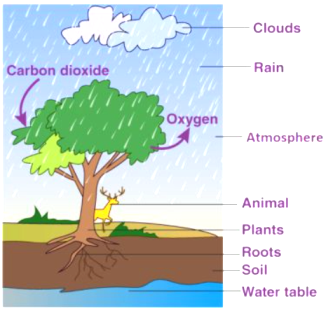NCERT Solutions Class 7 Science Chapter 17 Forests: Our Lifeline
1. Explain how animals dwelling in the forest help it grow and regenerate.
Answer:
Animals dwelling in the forest help it grow and regenerate in the following ways:
- Animals help in dispersing plant seeds.
- Decaying animal dung provides nutrients for plants to grow
- Microorganisms convert the dead plants and animals to humus
2. Explain how forests prevent floods.
Answer:
Plants in the forests will not allow the rainwater to fall directly on the earth, and these plants also hold water which helps in preventing floods.
3. What are decomposers? Name any two of them. What do they do in the forest?
Answer:
The micro-organisms which convert dead plants and animals to humus are known as decomposers. For example, bacteria and fungi. They help in the recycling of nutrients by decomposing dead plants and animals.
4. Explain the role of forests in maintaining the balance between oxygen and carbon dioxide in the atmosphere.
Answer:
Plants in the forests consume carbon dioxide and release oxygen through the photosynthesis process. This helps in balancing oxygen and carbon dioxide in the atmosphere.
5. Explain why there is no waste in a forest.
Answer:
There is no waste in a forest because the waste created is bio-degradable, which gets converted to humus by the action of microorganisms.
6. List five products we get from forests.
Answer:
The five products we get from forests are listed below:
i) Medicines
ii) Spices
iii) Wood
iv) Paper
v) Gum
7. Fill in the blanks:
(a) The insects, butterflies, honeybees and birds help flowering plants in _______.
(b) A forest is a purifier of ________ and ________.
(c) Herbs form the ________ layer in the forest.
(d) The decaying leaves and animal droppings in a forest enrich the ________.
Answer:
(a) The insects, butterflies, honeybees and birds help flowering plants in pollination.
(b) A forest is a purifier of air and water.
(c) Herbs form the lowest layer in the forest.
(d) The decaying leaves and animal droppings in a forest enrich the soil.
8. Why should we worry about the conditions and issues related to forests far from us?
Answer:
We should worry about the forest for the following reasons:
- A decrease in forests results in an increase in carbon dioxide content in the atmosphere. This results in global warming.
- Depletion of forests results in soil erosion
- The decrease in forests adversely affects the lives of animals living in the forest.
- The absence of forests leads to flooding more often.
- Due to the reduction of forests, the land will turn barren, which is called desertification.
9. Explain why there is a need for a variety of animals and plants in a forest.
Answer:
A variety of plants and animals in the forests helps plants to regenerate and grow. A wide range of plants supports herbivores, which in turn serve as food for carnivores. Decomposers turn dead animals and plants into humus, thereby maintaining nutrient recycling. This wide variety makes the forest a dynamic living entity.
10. In Fig. 17.15, the artist has forgotten to put the labels and directions on the arrows. Mark the directions on the arrows and label the diagram using the following labels: clouds, rain, atmosphere, carbon dioxide, oxygen, plants, animals, soil, roots, and water table.

Answer:

11. Which of the following is not a forest product?
(i) Gum
(ii) Plywood
(iii) Sealing wax
(iv) Kerosene
Answer:
Correct option is (iv) Kerosene.
12. Which of the following statements is not correct?
(i) Forests protect the soil from erosion.
(ii) Plants and animals in a forest are not dependent on one another.
(iii) Forests influence the climate and water cycle.
(iv) Soil helps forests to grow and regenerate.
Answer:
Statement (ii) Plants and animals in a forest are not dependent on one another.
13. Micro-organisms act upon the dead plants to produce
(i) sand
(ii) mushrooms
(iii) humus
(iv) wood
Answer:
Correct option is (iii) humus.